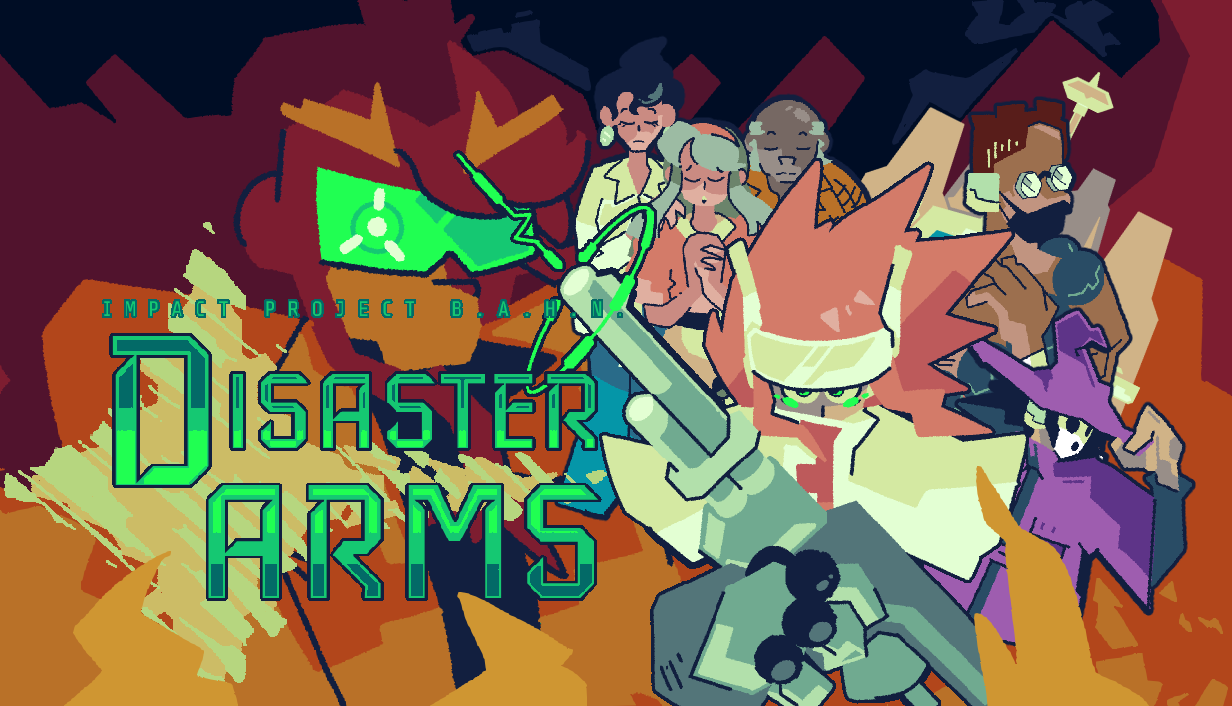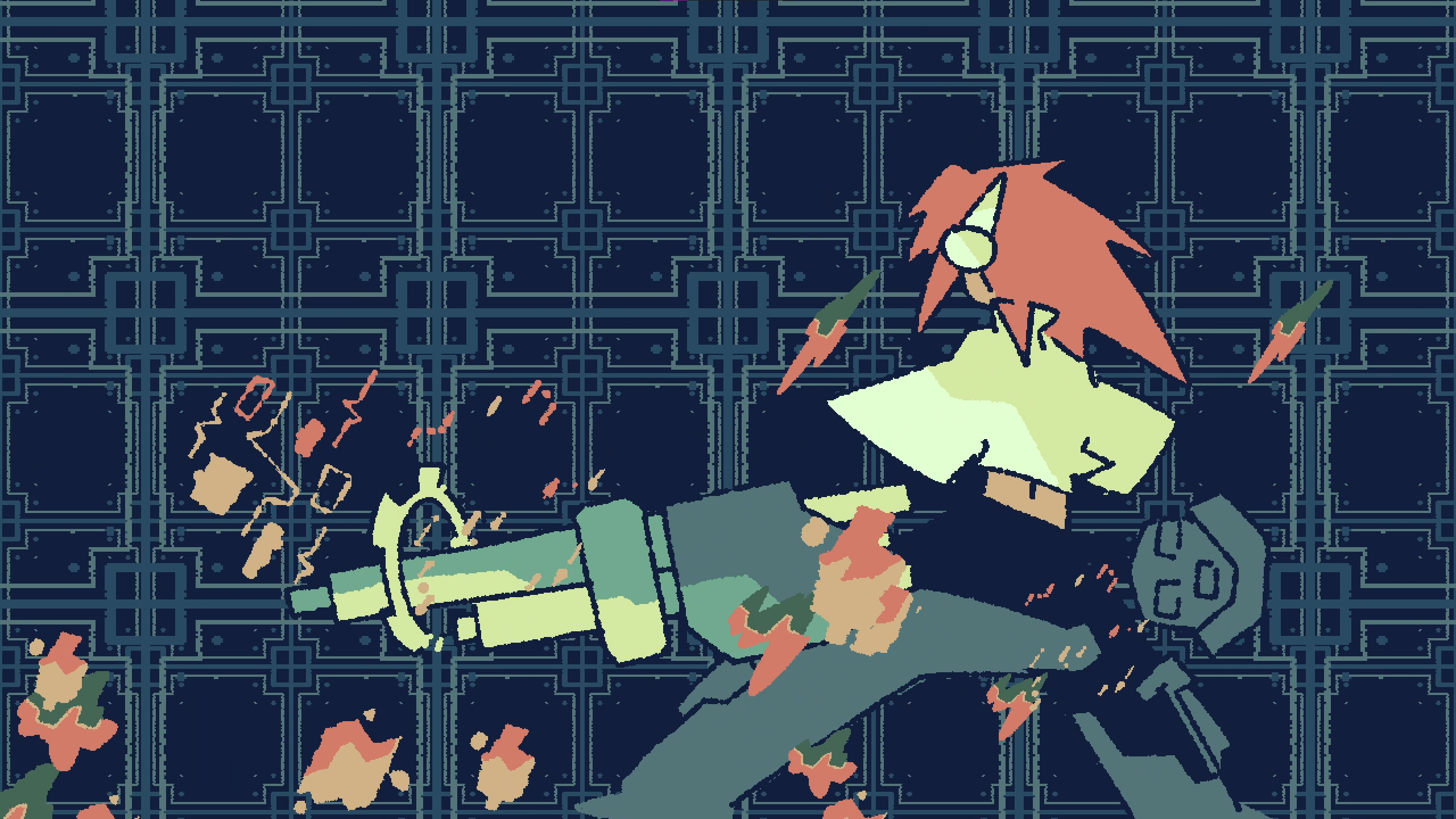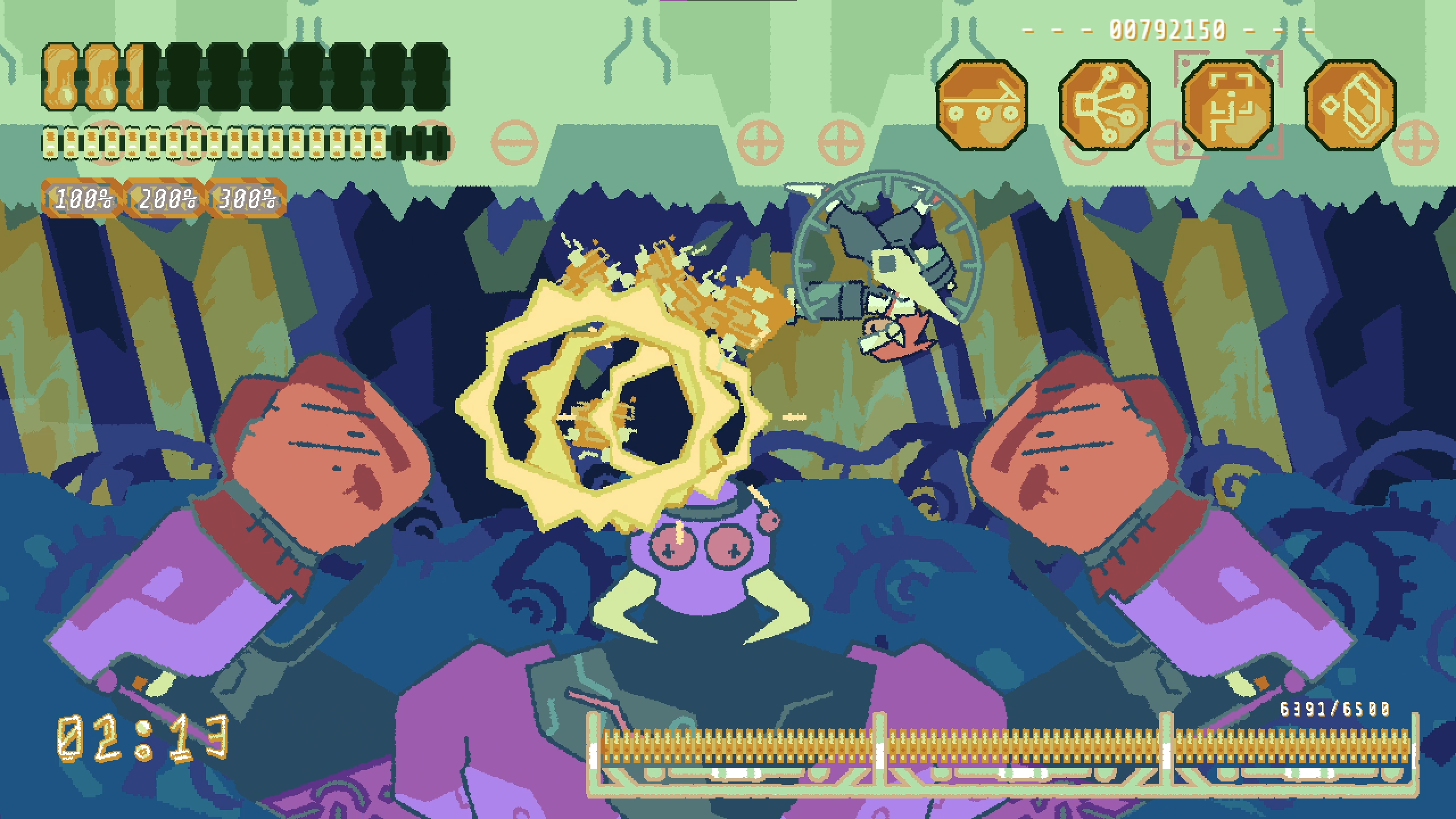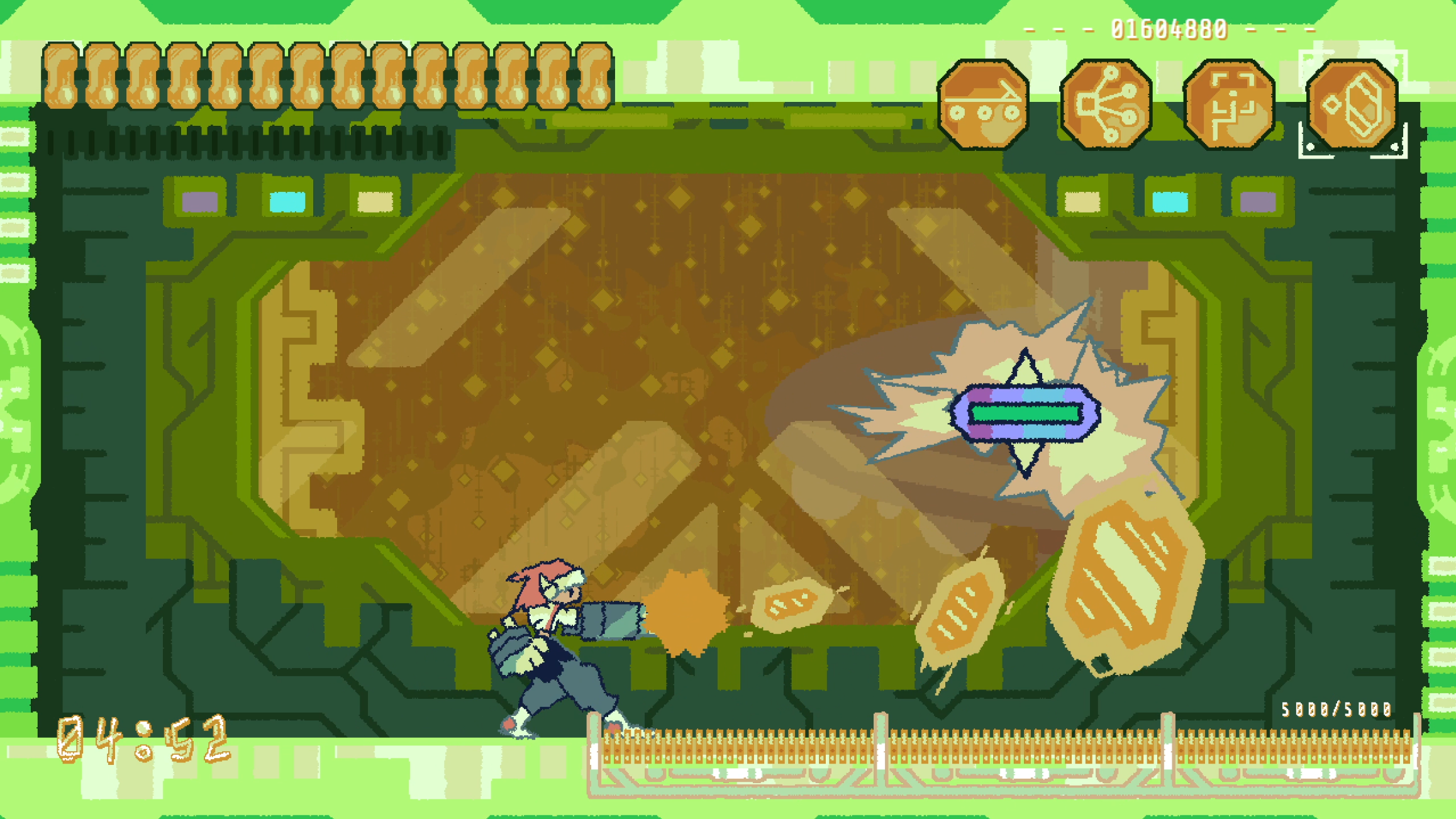Disaster Arms - Impact Project B.A.H.N. Review
 REVIEW COPY PROVIDED BY DEVELOPER.
REVIEW COPY PROVIDED BY DEVELOPER.
While it would be easy of me to praise Disaster Arms - Impact Project B.A.H.N. solely for the ways in which it replicates some of the weirder elements present in Alien Soldier, I think that would be a disservice to the things it does uniquely well. Truthfully I don’t even feel comfortable pointing the finger at just one title, as by the developer’s own admission there’s plenty of influences to be found here that may not even be apparent at first glance. I got in contact with the lead behind the project, and they state that Mega Man, Contra: Hard Corps, and G-Darius are just a few games they had in the back of their mind when assembling Disaster Arms. On top of that, the whole thing is wrapped up in this lovely sketchy style that makes the game feel equal parts retro and playful. “Nostalgic” is the low hanging fruit I could reach for here, but I mean that in the sense that it pulls me back to an older time generally speaking, not just for games - more 90’s Nick cartoons, less retro throwback games. These visuals bring everything together to create a tactile experience I can’t quite find elsewhere, and this extends equally to the gameplay.
 Watching this opening cutscene for the first time, I knew I was in good hands.
Watching this opening cutscene for the first time, I knew I was in good hands.
If you’re familiar with its influences then the basic framework shouldn’t be too surprising, but there’s plenty of adjustments in the way it handles that make things feel fresh and sharp. Character control feels responsive and air parries initiating inertia is a great touch, but it’s the control scheme that I feel deserves particular praise here. You have your basic jump, shot, and parry actions that line up nicely for a classic SEGA-style 3/6 button pad (while a legacy double-tap input for the parry exists, weapon ammo has been axed here so there’s no reason not to include a hotkey for it), two bumpers to toggle back and forth between your preset of four weapons, and a charge function mapped to the right bumper which I’ll get into more later. With the minimized amount of required buttons and mild customization offered in how you perform some actions, Disaster Arms is able to sidestep a lot of common issues with designing controls and manages to feel remarkably intuitive very early on.
A big problem I see developers encounter frequently in these retro throwback titles is in how to “modernize” an older type of game, and this often translates to muddled control schemes that feel difficult to wrestle with if you try to play on an older pad. Ninja Gaiden: RAGEBOUND is a particularly frustrating one for me I played recently, adding extraneous actions and inputs that make the game “feel better”, but at the cost of some of its retro roots. Having an extra button to utilize sub-weapons is an objective increase in the amount of control you have over your character versus the classic Ninja Gaiden games, but with hotkeys and a dodge button, is it really the same thing anymore? To me, control schemes can add to the flavor of a game more than most will give them credit for, so when you try to harken back to the era that feels particularly tuned for this type of design and pull away from that, something tends to feel lost to me.
While 99% of the user-base will play Disaster Arms on a 4 button + 4 shoulder pad, the deliberate choice to simplify things down to just 3 required inputs (jump, shot/parry, switch/charge) means the game can satisfy all crowds without straying too far from its identity. You can play this thing on an original 3 button Mega Drive pad and not be any less off! You may be cramped, but I appreciate the accommodation nonetheless. I must stress: busy control schemes kick a not-insignificant amount of ass, but smushing things together to elicit consideration in how you noodle your controller will always be more interesting to me than separating inputs and adding extra options.
 Before you’ve even experienced a second of gameplay, Disaster Arm’s arcade roots are displayed front and center.
Before you’ve even experienced a second of gameplay, Disaster Arm’s arcade roots are displayed front and center.
Another great piece of the pie that further ties into the “finger feel” of the game is the way weapons are configured. While the lack of a traditional ammo system may at first feel more like a downgrade than a conscious design decision, Disaster Arms goes one step further and limits the way you fire to a limited Mega Man style forward shot, with the added functionality of strafing to get in and out of the pocket without easing on the offensive. My biggest fear upon noticing the lack of ammo would be a potential gravitation toward the highest DPS weapons, but the lack of flexibility in its aiming meant I was always switching around to comfortably hit targets which, during moments where one switching button was held down to charge, felt tense as I tried to scramble for whichever weapon in the cycle made the most sense given the scenario.
The biggest omission you may feel if you’re coming at this with prior knowledge is the absence of any sort of invincible movement option to navigate the playfield, but this is far from a negative point. Movement in Disaster Arms may be basic by Psycho Game™ standards, but platforming and traversal has never really been the point of action shooters anyway, let alone this one. It’s not uncommon for a quick and invincible get-out-of-jail free card such as a roll or teleport to degrade the core gameplay experience, but while you certainly CAN design a game intelligently around a tool as powerful as this (see Alien Soldier with a dodge move so ridiculous that it sends you off to things off screen you can’t react to), its absence simply opens up the possibility of other distinctive gameplay qualities emerging.
Disaster Arms is no different, pitting you up against 30 gigantic bosses with huge waves of bullets and projectiles that are just dying to be dodged through, but more often than not must be grazed in true bullet-hell fashion. The lower of the three in-game difficulties is a bit looser with this, as this is where your parry covers the largest percentage of cancelable bullets, but the principles apply at all levels of play. Types of projectiles - signified by two distinct color telegraphs - can either be parried (“punched” in the context of the game) or not, and similar to Alien Soldier, this small amount of leeway is a smart consideration to make patterns more manageable. Crucially, your punch in Disaster Arms comes with a hefty amount of cooldown, and this can really get you into some trouble when using it as a defensive wall to get past bullets. It’s an impossible thing to mash and keep up forever, so even against a spread of parryable bullets, at some point or another you’ll have to really consider placement and timing to not screw yourself over for the incoming blast. In these small but frequent moments of “downtime”, the developer’s previous experience with the genre shows in full, and Disaster Arms is able to conjure the feelings you get dodging patterns in a traditional shmup, and that’s not even something you can get really from Alien Soldier, at least not in the same way.
Assisting with these thrills is an overall strong consideration for challenge, backed up nicely by a smooth on-ramp to the game’s “true” form in its highest selectable difficulty sporting some more aggressive fodder enemies and brilliantly reconsidered boss patterns. While their movements remain unchanged and the same parry rules apply, the adjustments made to staggered fire and the properties of projectiles themselves ensure that you’ll more often than not have to switch up your entire strategy and flow for many bosses in the back end of the game. This was a delightful thing to discover, going up against bosses I had fought dozens of times but with the added pressure of relearning waves of shots and reconsidering when to utilize my parry, ultimately resulting in a knock-on effect for the game’s overall economy.
I don’t want this whole thing to just be a compare and contrast piece with Alien Soldier, but at least one more thread is important to bring up here. In that title, getting to max health and spending HP cashed in on the game’s defining tool, the Phoenix Force. This move turns your pre-existing dodge into a nuke, wiping out most bosses in a single strike and turning the tides of any fight you use it in. On top of that, this also ripped through projectiles and turned them into health pickups, feeding back into itself and creating a loop you can take advantage of and dominate the game.
 Sunset Sting’s constant stream of bulbs in the fight serve the dual purpose of being threatening to the player while also acting as a means to top off your health. Occasionally you’ll find yourself using the Phoenix Force and topping it off in the same motion, allowing for back and forth repeated uses that feel amazing to pull off.
Sunset Sting’s constant stream of bulbs in the fight serve the dual purpose of being threatening to the player while also acting as a means to top off your health. Occasionally you’ll find yourself using the Phoenix Force and topping it off in the same motion, allowing for back and forth repeated uses that feel amazing to pull off.
A similar mechanic exists in Disaster Arms, but the balance has totally flipped here. Instead of utilizing health pickups for your most powerful ability, enemies and bosses drop Chips tailored specifically for a meter used to cash in for the Ignition Dash. While keeping fundamentally similar properties and allowing for familiar loops by constantly grabbing items and immediately burning your bar, the need to fill an entire meter ensures you won’t solely be relying on back to back dashes to drain boss health bars. There’s even some fun bit of routing to consider as well, with the meter “topping off” three times and multiplying its own power with each fill, leading to interesting scenarios where it’s possible to go into a fight with most of your meter filled up, immediately use your Dash, and top off another bar to use the Dash again quickly. Additionally, an interesting decision was made here requiring the Dash to be charged up for a few seconds before letting it rip. Beyond just acting as an incredible dopamine hit you’ll be falling back on at all times in a run, this is the final piece of the control scheme that makes the basic hand feel of the game feel so distinct.
Oftentimes you’ll find yourself charging and holding a Dash well in advance of needing to use it to offset the startup, but now you’ve tied yourself down with a clamped finger and one less weapon switching button to utilize. Some of the game’s best moments, from hanging upside down while switching back and forth between boss limbs to time an Ignition Dash perfectly, to performing the general finger gymnastics required to comfortably jump, shoot, and react with parry as needed, add so much texture to the game that is sorely missing from much of what I’ve played recently. A full button remapping menu and a modern controller may go some way towards making the experience more comfortable on a widely accessible scale, but in my experience playing over 16 hours for review on an 8Bitdo M30, I wouldn’t want to have it any other way.
 One of the game’s standout bosses, and one of the best showcases for how dizzying it can be at times.
One of the game’s standout bosses, and one of the best showcases for how dizzying it can be at times.
Alongside the critical shift in design for the most powerful tool in the game, healing has now been delegated to rare pickups within stages itself, making the general experience of the game far more consistently tense than it did before. You don’t have opportunities to fill up on health at every point in the game, so mistakes feel properly devastating and the threat of failure is always more immediate (ADDENDUM: I’ve been informed that topping off your meter while you have a 300% Ignition Dash stocked will actually grant a small amount of health. Shocked I never caught onto this, and it doesn’t change that bosses are still extremely punishing, but I wanted to make a note of this in post anyway. Cool mechanic!). Ultimately, the goal is to avoid mistakes to begin with and it’s not like the transitional stages between bosses are designed to kill you anyway, but the experience of “getting good” to build up to a 1CC of any game is an irreplaceable one, and gains so, so much from having a little bit of bite at all levels of play. Still, making mistakes and working around the health economy of the game would be nothing if the bosses themselves didn’t put up a fight, and luckily that’s not a concern in the slightest here.
Genuinely, I couldn’t go a whole piece talking about a boss rush style run-and-gun without dedicating extra time to the bosses, because they’re nothing short of a triumph here. While the first few feel like tutorial fodder once you get a feel for the expectation and balance of the game (Punch -> Ignition Dash alone immediately ends many early fights), it doesn’t take long for encounters to get extremely creative and threatening. Not having any proper movement tools means you’re often tasked with going up against figurative or literal walls that refuse to stop slinging torrents of shit your way to dodge, but to my delight, Disaster Arms doesn’t stray away from smaller agile foes that force you to actually navigate around the field the ol’ fashioned way. We lost the plot years ago when bosses stopped being assembled and drawn like puppets of pointlessly complicated machinery and joints, and while I wouldn’t dare spoil some of my favorites here, let’s just say PD_CGT knew ball when drawing up the fights.
 ???????
???????
Perhaps the greatest triumph of Disaster Arms, beyond being an excellent game in its own right, is that it so effortlessly gets to the heart of what made Alien Soldier and its other proudly displayed influences so special to begin with. Wholly independent ideas are indispensable for any medium, but it is the nature of art to react and refine just as much as it is to articulate. If burgeoning designers want to get to the heart of what makes a given piece so special, it helps to have not just a baseline, but a basis for comparison. After all, what matters most when lifting up quality art for future generations is being able to communicate what makes it so special to begin with, and often that comes with iteration. Being “iterative” has become a bit of a sour quality in the eyes of some, but there’s nothing inherently wrong with that. Disaster Arms proudly wears its inspiration on its sleeves and justifies these long-abandoned ideas with such grace that you have to wonder why this formula wasn’t copied 30 years ago. Hopefully this title inspires other designers to take a crack at these ideas and shape them into their own package, because the indie space will feel pretty empty without more games like it in the future.
LAUNCH DAY ADDENDUM
Much to my surprise, there’s been a quiet patch that doesn’t invalidate my thoughts, but imo requires some mentioning. This review was written pre-launch, and at that point damage output was tied to the framerate of the game, resulting in fights ending much faster than they were supposed to. This has since been ammended, but my muscle memory (and my beloved 25 minute Advance Mode clear time) are gone with the wind. This doesn’t change my overall thoughts though - Disaster Arms is still a tremendous game from top to bottom. I can only speculate as I now have to re-learn the game in a sense, but this feels like an exclusively positive change. While I never minded how fast bosses went down before as it fed into routing and execution considerations I mentioned in my initial review, having to engage more with the considered bullet patterns is a delightful proposition to me. I suspect I’m now really far off from a 1CC on any of the game’s primary difficulties, but this setback doesn’t effect my verdict in the slightest. This game is essential in a way I haven’t felt in a while and is a must play for everyone, regardless of your percieved level of skill. Absolutely essential reading for self-proclaimed arcade-heads.
Comments
You can use your Bluesky account to reply to this post.